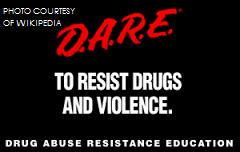
The anti-drug campaign called Drug Abuse Resistance Education, otherwise known as DARE, was established in 1983. Starting with students in fourth or fifth grade, DARE teaches the prevention of drug use, gang membership and violent behavior; but the DARE program faces high scrutiny and criticism on how effective it actually is towards adolescents.
Instructors of the DARE program are local police officers who undergo eighty hours of training in: child development, classroom management, teaching techniques and communication skills. An additional forty hours of training is needed for instructors who plan on teaching high school students. The police officers lead the students in multiple discussions and interactive activities.
39.9% of students have used marijuana one or more times and 60% of high school students who attend a public school claim that their school is “drug-infected” meaning students use or sell drugs on school grounds. Why are the percentages so high for teenagers if they were informed about the harms of drugs at a young age by the DARE organization?
Teens can easily catch on when someone is over-exaggerating — something the DARE instructors tend to do when describing the dangers of prescription or recreational drugs. For example, if a teenager hears about a talented athlete or intelligent student who smokes a relatively harmless drug like marijuana on the weekend, but is still able to perform at a high level, they’ll become skeptical about how accurate DARE’s information is.
Some anti-drug campaigns lead to curiosity about drugs, which increases drug use among its peers. At one point or another, most parents will have a talk with their children about drugs. Research shows that parents talking about their own drug use in the past should be avoided because their children will be less likely to exhibit a more anti-drug attitude.
Anti-drug campaigns that only emphasize the risk of drug uses aren’t going to reach out to all teens. Campaigns like Be Under Your Own Influence stress the importance of independence within teenagers. Be Under Your Own Influence, ran by the Office of National Drug Control Policy, emphasizes that prescribed or recreational drugs can undermine a young man or woman’s ability to achieve their own personal goals.
32 schools in 16 communities around the country participated in Be Under Your Own Influence and researches found that within two years the amount of people who consumed alcohol or drugs was cut in half compared to adolescents not participating in the Be Under Your Own Influence program.
According to Michael Slater, an anti-drug campaign expert at Ohio State University, “Adolescents are about becoming independent, autonomous and effective people. Thats what they want to do. If drug use is perceived as a way to demonstrate independence and autonomy, people discouraging drug use are going to have an uphill battle.”
Campaigns that emphasize adolescents being independent and allowing them to make up their own minds while being aware of the potential consequences are the most beneficial when trying to lower the percentage of drug users.